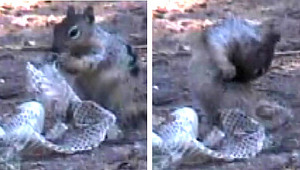
|
| ©Video stills courtesy Barbara Clucas
|
| Video stills show a ground squirrel chewing on a rattlesnake's shed skin and then licking its body to apply the masticated mush. The act most likely persuades serpents that another snake, not a squirrel, is in the area. A new study suggests that this behavior is part of a host of tricks the squirrels have evolved to use to avoid predation.
|
To mask their odor from rattlesnakes, California ground squirrels and rock squirrels chew on sloughed-off snake skin and smear it on their fur, according to a new study.
The act most likely persuades the predators that another snake, not a squirrel, is in the area.
"To our knowledge this is the first case where [this idea] has been tested systematically and shown to have an anti-predator function - protecting the squirrel from rattlesnake predation," said study lead author Barbara Clucas.
Clucas, a graduate student in animal behavior at the University of California, Davis, said she first noted this behavior in 2002.
She saw rock squirrels at Caballo Lake State Park in New Mexico licking themselves to apply chewed snake skin to their flanks, tails, and rear ends, which gave them the pungent, musky scent of a rattlesnake.
In 2003 she saw California ground squirrels at Lake Solano County Park in California doing the same thing. (
See a squirrel photo gallery.)
Her team's study of the squirrels appeared in the November issue of the journal
Animal Behaviour.
Eau de Rattlesnake
Rattlers and other snakes usually prey on baby squirrels, because the adults have proteins in their blood that make them immune to snake venom.
Pups, on the other hand, aren't big enough to resist the poison.
Clucas and colleagues therefore think that adult female and juvenile squirrels spend more time applying snake scent to their bodies.
"Adult females actively protect their pups ... and share their burrows with juveniles," Clucas said.
"So if the snake-scent application prevents rattlesnakes from entering squirrel burrows, both the adult females and the juveniles would need to apply the scent."
Study co-author Donald Owings, a professor of psychology at UC Davis, noted that scent application is just one trick in a suite of defenses that squirrels use against rattlesnakes.
In previous studies, Owings' lab had found that
ground squirrels heat up their tails by as much as nine degrees Fahrenheit (five degrees Celsius) to send a warning signal to rattlesnakes.
"Squirrels have over time learned to lessen their chances of becoming prey," said Chris Jenkins, a scientist with the Wildlife Conservation Society, who was not part of the study.
"Sometimes it gets to a point where the squirrels will start kicking sand at the snakes, biting them, and pouncing on them," Jenkins added.
"This new behavior that [Clucas and her colleagues] documented adds a whole other angle to the story and has real implications for our understanding of predator-prey dynamics."
"Beauty" of Evolution
The study authors add that snake-scent application is likely a product of natural selection.
Squirrels that had the genetic instinct to use the ploy might have had increased survival and reproductive success, thus passing the trait to following generations.
Co-author Matthew P. Rowe, a behavioral biologist from Sam Houston State University in Texas, said he finds this genetic aspect fascinating.
"It gives me great cause to admire the beauty of these interactions, which are the products of millions of years of evolution."
Animals that call themselves humans actually seem to work at lowering their foreheads and work against evolution.